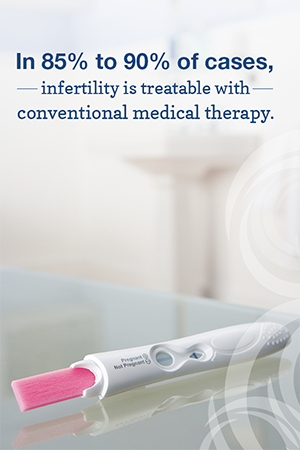Researchers at and supported by NICHD are investigating the causes of infertility and identifying new effective treatments. One line of research examines the contributions of environmental factors to infertility. Another explores how the physical changes associated with diseases, such as endometriosis, relate to infertility. Investigators are also studying why African American women have lower success rates using assisted reproductive technology (ART). Learn more about NICHD support of research on ART and women's health, and review some recent advances in advancing ART methods, achieving optimal conditions for ART, and understanding its long-term effects in the Assisted Reproductive Technology (ART) and Women's Health fact sheet. In addition, research is being conducted to determine new ways to preserve fertility and to better understand the effect of aspirin on live-birth rates.
Research on the effects of environmental factors on infertility is conducted in NICHD's Division of Population Health Research (DiPHR). For example, researchers in the Division collaborated with scientists at the University of Buffalo to study the relationship between hormone levels and oxidative stress during the menstrual cycle to elucidate the effects of diet, smoking, and caffeine on fertility. DiPHR scientists also studied the link between psychological stress and infertility in women. Additionally, DiPHR scientists are looking at the effect of environmental toxins and lifestyle factors on men and women's fertility. The Longitudinal Investigation of Fertility and the Environment (LIFE) Study is examining the long-term effects of lifestyle factors, including stress, cigarette smoking, caffeine intake, and alcohol usage, on fertility. These researchers found that men who worked in physically demanding jobs or took two or more medications had lower sperm counts. Men with high blood pressure, but not those with diabetes or high cholesterol, had less normally shaped sperm. Lower sperm quality or number can make it harder for a couple to conceive.
The Epidemiology Branch within DiPHR conducts research and provides services and training. Its epidemiologic research focuses on reproductive, perinatal, and pediatric health endpoints to identify underlying etiologic mechanisms, at-risk subgroups, and interventions aimed at diagnosing or treating disease. An ongoing investigation, called the Effects of Aspirin on Gestation and Reproduction (EAGeR) Study, is investigating the effects of aspirin on blood flow and placental health to reduce the risk for adverse pregnancy events, such as early pregnancy loss and preterm birth.
The Unit on Reproductive Endocrinology and Infertility (UREI) in the Division of Intramural Research (DIR) is also actively researching both treatments for and causes of infertility. For example, women and girls with cancer who undergo chemotherapy treatments are exposed to chemicals that can affect the ovaries and lead to infertility. Studies conducted by UREI scientists have examined ways to prevent this damage. Another study conducted by UREI scientists examined procedural differences in ART that might account for differences in pregnancy rates among African American women and whether access to care and economic issues affect use of the technologies by minority women.
Intramural scientists within the Reproductive Endocrine and Gynecology Group at NICHD are examining possible causes and treatments for infertility associated with primary ovarian insufficiency (POI). Animal studies have explored molecular pathways involved in the loss of ovarian function and ways to intervene within the pathways to prevent loss of ovarian function. These investigators have studied women with POI to better understand the features of the disease, how it causes infertility, and how infertility can be treated in these women.
The NICHD Fertility and Infertility (FI) Branch, within the Division of Extramural Research (DER), supports research on a variety of topics related to fertility and infertility. This Branch supports the Reproductive Medicine Network, which studies new and effective ways to evaluate and treat infertility in males and females. Findings include new treatments for ovulation induction in infertile women with polycystic ovary syndrome (PCOS) and the optimal treatment for unexplained infertility that results in fewest multiple gestations.
Preserving fertility is also topic of considerable interest for the FI Branch. Current investigations address the concerns of fertility preservation for men, women, and children, for circumstances covering cancer treatment and certain non-cancer conditions. Specifically, Institute-sponsored research investigates measures to prevent gamete damage, options to restore fertility after damage, developing biomarkers of gamete reserve, and the developing technologies that will enable reproductive-age adults to have biological children. One FI Branch-supported study identified a variant of a gene that helps explain why women with PCOS produce higher levels of male hormones. Women with PCOS produced higher levels of a specific gene variant in cells in their ovaries, and these cells then produced higher levels of androgen.
Other FI Branch research areas related to fertility and infertility include:
- Early pregnancy loss (EPL) with emphasis on developing methods to predict those at risk for EPL and understanding the role of oocyte aneuploidy, sperm quality, and pre-placental processes
- Genetics of male and female infertility, including idiopathic infertility
- Improvement of fertility preservation outcomes through developing novel technologies
- Ovarian aging, with special focus on understanding factors that affect egg quality; how the primordial follicle pool is established, regulated, and altered over time; and new methods to assess and predict the ability of the ovary to supply eggs for fertilization
- The relationship between male fertility status and health of their offspring
- The requirements of ovulation, egg fertilization, and embryo implantation
- The effects and mechanisms of diseases such as endometriosis and PCOS on fertility and effective treatments for these disorders
- Growth and development of sperm and factors that affect sperm development, function, and quality
Research related to infertility supported by the NICHD Pregnancy and Perinatology Branch (PPB) focuses on maternal health and healthy pregnancy, as well as on pregnancy loss and stillbirth.
Other DER research supported by the Populations Dynamics Branch focuses on understanding changing patterns of family formation, including cohabitation, marriage, non-marital fertility, infertility, and low fertility.
Institute advances in infertility research include the following:
- Identification of a potential nonsurgical method for diagnosing endometriosis. Endometriosis, a painful condition that can cause infertility, is currently diagnosed using a surgical procedure, termed laparoscopy. Researchers compared which genes were turned on in uterine tissue of women with and without endometriosis. Using these differences, researchers were able to predict which women had endometriosis and distinguish between endometriosis and other uterine problems. The researchers are testing the method in a larger population of women and hope to eventually develop a non-surgical test for endometriosis. Visit High-Tech Analysis of Genetic Data May Yield New Test for Endometriosis for more information.
- Discovery that a chlamydia test can predict chances for pregnancy.Chlamydia trachomatis infection might cause few or no symptoms, but it can cause inflammation and scarring in the fallopian tubes, leading to infertility. An NICHD-funded study looked at the link between C. trachomatis and pregnancy outcomes in women whose infertility is not explained by having blocked fallopian tubes. Researchers used a blood test to detect a previous or existing C. trachomatis infection and followed these women as they underwent fertility treatment. Women who tested positive were less likely to become pregnant or have a live birth and more likely to have an ectopic pregnancy. The researchers suggest it is important to screen infertile women for C. trachomatis infection and screen for other forms of tubal damage besides blockages. See Blood test for chlamydia may predict pregnancy outcomes for more information.
- Discovery that a cancer drug improves pregnancy outcomes for women with PCOS. PCOS is a leading cause of infertility in women. Although the drug clomiphene is used to treat PCOS infertility, it has side effects and is not greatly effective. NICHD-supported researchers compared clomiphene to the cancer drug letrozole. Women treated with letrozole were more likely to have live births than those treated with clomiphene. Letrozole also led to higher rates of ovulation than clomiphene. See Drug Improves Birth Rates for Women with Fertility Disorder for details.



 Treatments for infertility can range from medications to embryo implantation through assisted reproductive technology (ART). There are treatments that are specifically for men or for women and some that involve both partners. In 85% to 90% of cases, infertility is treated with conventional medical therapies, such as medication or surgery.
Treatments for infertility can range from medications to embryo implantation through assisted reproductive technology (ART). There are treatments that are specifically for men or for women and some that involve both partners. In 85% to 90% of cases, infertility is treated with conventional medical therapies, such as medication or surgery. Research consistently shows that lifestyle factors—what you eat, how well you sleep, where you live, and other behaviors—have profound effects on health and disease. Fertility is no exception.
Research consistently shows that lifestyle factors—what you eat, how well you sleep, where you live, and other behaviors—have profound effects on health and disease. Fertility is no exception. BACK TO TOP
BACK TO TOP